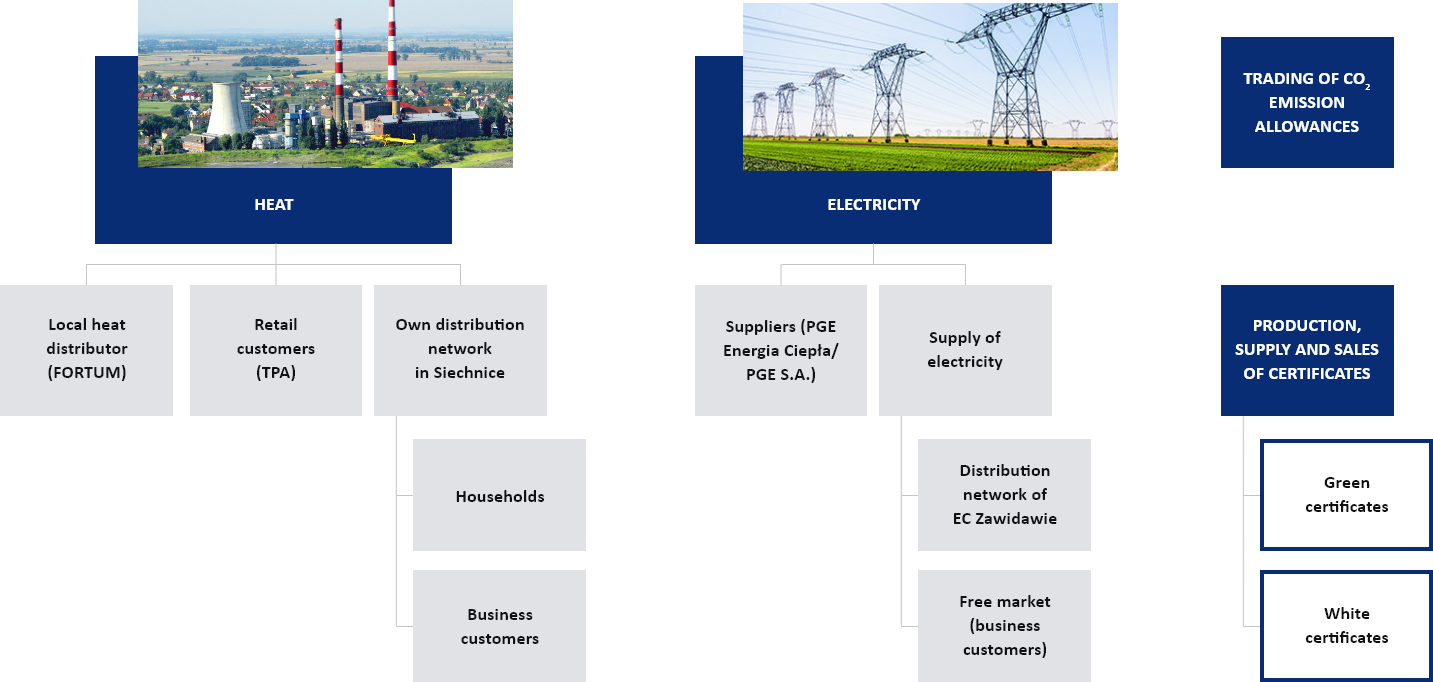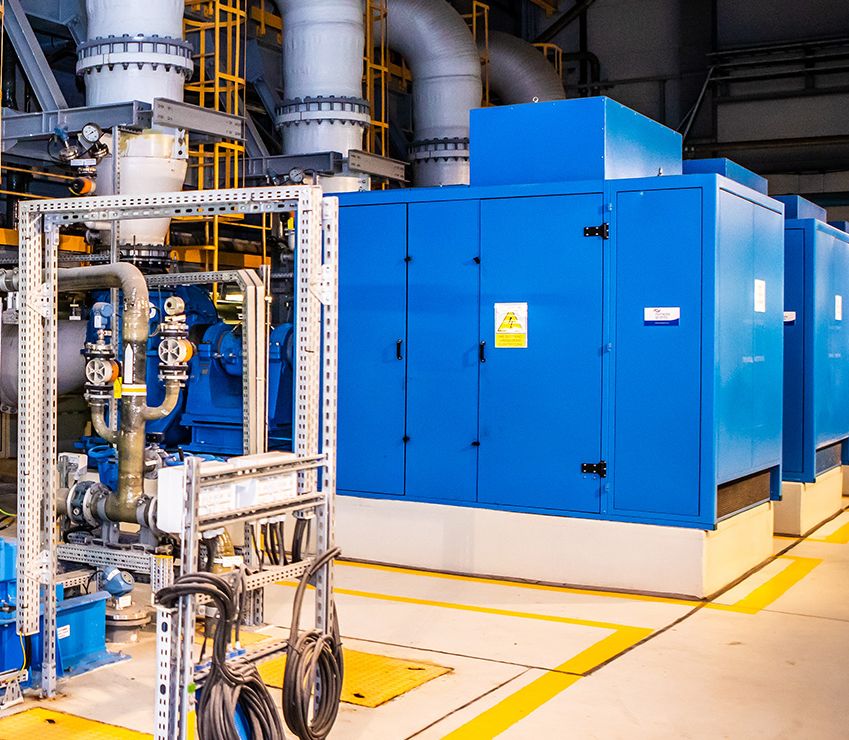Business model
Zespół Elektrociepłowni Wrocławskich KOGENERACJA SA consists of three production plants with a total electrical capacity of 366 MW and heating capacity of 1 080 MW. KOGENERACJA SA is a producer of network heat and electricity through cogeneration.
As a producer of heat for Wrocław and its surroundings, the Company satisfies the demand for heating, domestic hot water and technological heat and generates electricity as part of the national power system. Heat and electricity are produced by way of cogeneration, which ensures highly efficient average yearly production due to the most effective utilization of chemical energy of primary fuels in the entire energy sector. Network heat and electricity are primarily produced using hard coal and biomass.
Chart. The business model of KOGENERACJA S.A.

EC Zielona Góra S.A. is a commercial enterprise producing heat and electricity in a combined system. The company produces electricity through cogeneration in the CC Gas Unit with an installed capacity of 198 MW. It owns a heating network and is a distributor of heat.
Heat is the main product produced in the combined system at KOGENERACJA SA. It is sold to local customers (Wrocław, Siechnice) in the form of hot water.
The price of heat is regulated (tariffs for heat are subject to approval by the President of the Energy Regulatory Authority (URE)). Heat is sold to Fortum Wrocław, a distributor company but also directly to retail customers. The company distributes heat through its own network in Siechnice.
EC Zielona Góra S.A. also produces heat in a combined system. It also owns a heating network and is a heat distributor. It is the only supplier of heat to the district heating system and of hot domestic water in Zielona Góra (Elektrociepłownia Zielona Góra S.A. is the owner of this system). The share of Elektrociepłownia Zielona Góra S.A. in the heat market in Zielona Góra amounts to 44%. The heating networks are 123.82 km long (including 75.19 km of pre-insulated lines). The company operates nine local gas boiler plants.
KOGENERACJA S.A. produces electricity in combination with heat at three plants: EC Wrocław, EC Czechnica and EC Zawidawie, from where the generated heat and power are transmitted to distributors. Electricity is sold through the trading company PGE Energia Ciepła S.A.
Since August 2004, EC Zielona Góra S.A. has mainly produced electricity in the CC Gas Unit in a partial cogeneration process by using gas fuel (gas from local sources).
KOGENERACJA S.A. obtains certificates of origin mainly from cogeneration (red and yellow certificates) and from co-firing of biomass (green certificates). EC Zielona Góra S.A. obtains certificates of origin from cogeneration (yellow certificates).
Certificates are traded through PGE Energia Ciepła S.A., a trading company. The companies are required to redeem certificates due to the sale of electricity to end users also through PGE Energia Ciepła S.A.
The Group purchases and sells CO2 emission allowances through PGE Energia Ciepła S.A. The companies independently redeem CO2 emission allowances in keeping with the actual emissions.
Group structure
KOGENERACJA Group includes the Parent Company KOGENERACJA S.A. with its registered office in Wrocław and one subsidiary Elektrociepłownia Zielona Góra S.A. with its registered office in Zielona Góra. KOGENERACJA S.A. has a 98.4% in its share capital and voting power.
Certified management systems
Each Group company has Integrated Management Systems, which include:
- Quality Management System compliant with the PN-EN ISO 9001:2015 standard,
- Environmental Management System, compliant with the requirements of the PN-EN ISO 14001: 2015 standard,
- Health and Safety Management System compliant with PN-N-18001:2004 and OHSAS 18001:2007 standards.
Risk management
The Group Companies have a *Corporate Risk Management Procedure*. The procedure defines the organization of control activities ensuring proper risk management in the Group. In addition, the *Credit Risk Management Policy, the Trading Market Risk Management Policy and the Internal Audit Regulations* apply in this area.
The Management Board of each of the Companies conducts independent monitoring of the following risks: financial, legal and environmental, operational, market, public and media risks and investment risks. Risk maps are presented at Supervisory Board meetings.
By identifying the risks together with an analysis of the probability of their occurrence and possible impact on the Company, key non-financial risks were selected.
Table. Key non-financial risks
| Non-financial risks | Risk level | Activities | |
|---|---|---|---|
|
Operational risks |
Human resources – related to the provision of personnel with appropriate experience. Competence and ability to perform specific tasks. |
|
|
| Social dialogue – related to maintaining a constructive and effective dialogue with the social side. |
|
||
| Compliance – related to counteracting to the phenomena of fraud and corruption. |
|
||
|
Regulatory and legal risks relating to the fulfilment of the requirements laid down when it comes to legislation |
Environmental protection – related to protection environments |
|
|
|
Health and safety at work – related with compliance with health and safety standards/rules |
|
Key non-financial performance indicators reflecting the operations of the KOGENERACJA S.A. Group
In the process of managing operations and making decisions, the following non-financial indicators are particularly taken into account:
- Total number of accidents related to the employees’ work
- Total number of accidents related to contractors’ work
- Raw materials consumption
- Air emissions
- Average number of training hours per year and training costs
- Number of employees by type of employment and employment contract, broken down by gender (persons).

